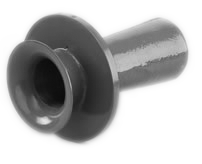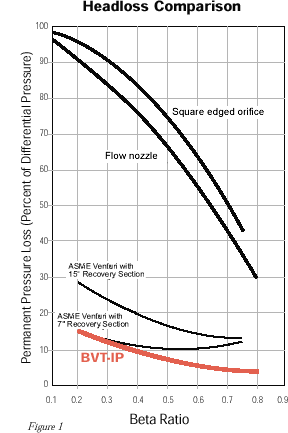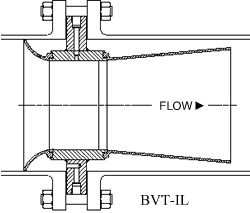 Wyatt Venturi Tubes
Wyatt Venturi Tubes
Insert-Type Composite Primary Elements
Features:
- High Accuracy
- Economical Design
- Low Pressure Loss
- Reliable Performance
Description
The Wyatt BVT insert venturi is available in two configura-tions: The standard BVT-IP, made entirely of engineered materials, and the BVT-IL, which uses a metallic throat and mounting flange and a fiberglass reinforced body. The BVT-IP and BVT-IL are designed for insertion within the interior of a pipeline and are secured by adjacent pipe flanges. Wyatt insert venturis are low-weight and cost-effective alternatives to other meter geometries and designs.
Application
The BVT insert venturi design provides higher accuracy over a wider range of flow rates, and lower permanent pressure loss than orifice plates, flow nozzles, or conventional venturi meters. Designed to measure clean liquids and gases in full pipes, the insert BVT can be manufactured to fit virtually any pipe size. In applications where solids contam-inate the line fluid, an auxiliary
high pressure tap can be provided for installation in the upstream pipe.
Flow Measurement Accuracy
For pipe Reynolds numbers greater than 75 000 and with a normalized piping configuration, the Wyatt BVT-IP and BVT-IL provide a flow measure-ment accuracy of ± 0.25% with independent flow calibration. Without independent flow calibration, the Wyatt BVT-IP and BVT-IL provide a flow measurement accuracy of ± 0.50%.
BVT-IP Technical Specifications
Accuracy
For pipe Reynolds numbers greater than 75 000 and a normalized piping configuration, the Wyatt BVT-IP and BVT-IL provide flow measurement
uncertainties of:
± 0.50% for standard meters and
± 0.25% for flow calibrated meters.

Pressure Loss
The permanent pressure loss of Wyatt insert meters is considerably lower than that of short-form venturis, and for most beta ratios, lower than that of long-form venturis as well.
(See Figure 1)
Beta Ratio
Wyatt insert meters can be furnished in a wide range of beta ratios (d/D), providing accurate and reliable primary elements with low permanent pressure loss.
Temperature Range
The composite design insert BVT series of primary devices is designed to operate within process temperature range of 0 °F to +300 °F (-18 °C to +150 °C).
Pressure Range/Flange Connections
Depending on process conditions, the standard design BVT-IP can operate at pressures up to 750 PSIG (5175 kPaG). The BVT-IL, due to its metallic mounting flange, operates at pressures up to 4000 PSIG (27 500 kPaG).
Piping Requirements
Designed for full-pipe flow, BVT-IP and BVT-IL insert meters can be installed in horizontal or vertical lines. For recommended upstream piping, refer to Wyatt Engineering Technical Manual for the BVT.
Design Concepts
The hydraulic design produces discharge coefficients that are highly predictable and independent of line size. The Wyatt design allows accurate calculation of expansibility factors that are necessary for compressible fluid flow measurement. The smooth transition section minimizes flow noise and erosion.
Signal-to-Noise Ratio
Within the specified flow range and piping conditions, the Wyatt will produce signal-to-noise ratios greater than 98%. This level of performance is essential for sensitive process control and reactive rate-of-flow control applications.
BVT-IP Available Options

Materials of Construction
The Wyatt insert series of flow meters can be constructed of virtually any composite material, such as vinyl ester or isophthalic resin, reinforced with fiberglass or carbon fiber. Consult Wyatt Engineering for available materials.
Model BVT-IP: In the BVT-IP series, the body is typically constructed of vinyl ester resin reinforced with fiberglass (40% by weight). The throat can be constructed of polyvinyl chloride, FRP, or almost any other synthetic material.
Model BVT-IL: Like the BVT-IP, the meter body of the BVT-IL is generally constructed of vinyl ester resin reinforced with fiberglass (40% by weight). The BVT-IL typically incorporates a bronze, 304 stainless steel, or 316 stainless steel throat. Consult Wyatt Engineering for other available throat materials.Consult your local representative or Wyatt Engineering for information on other materials of construction.